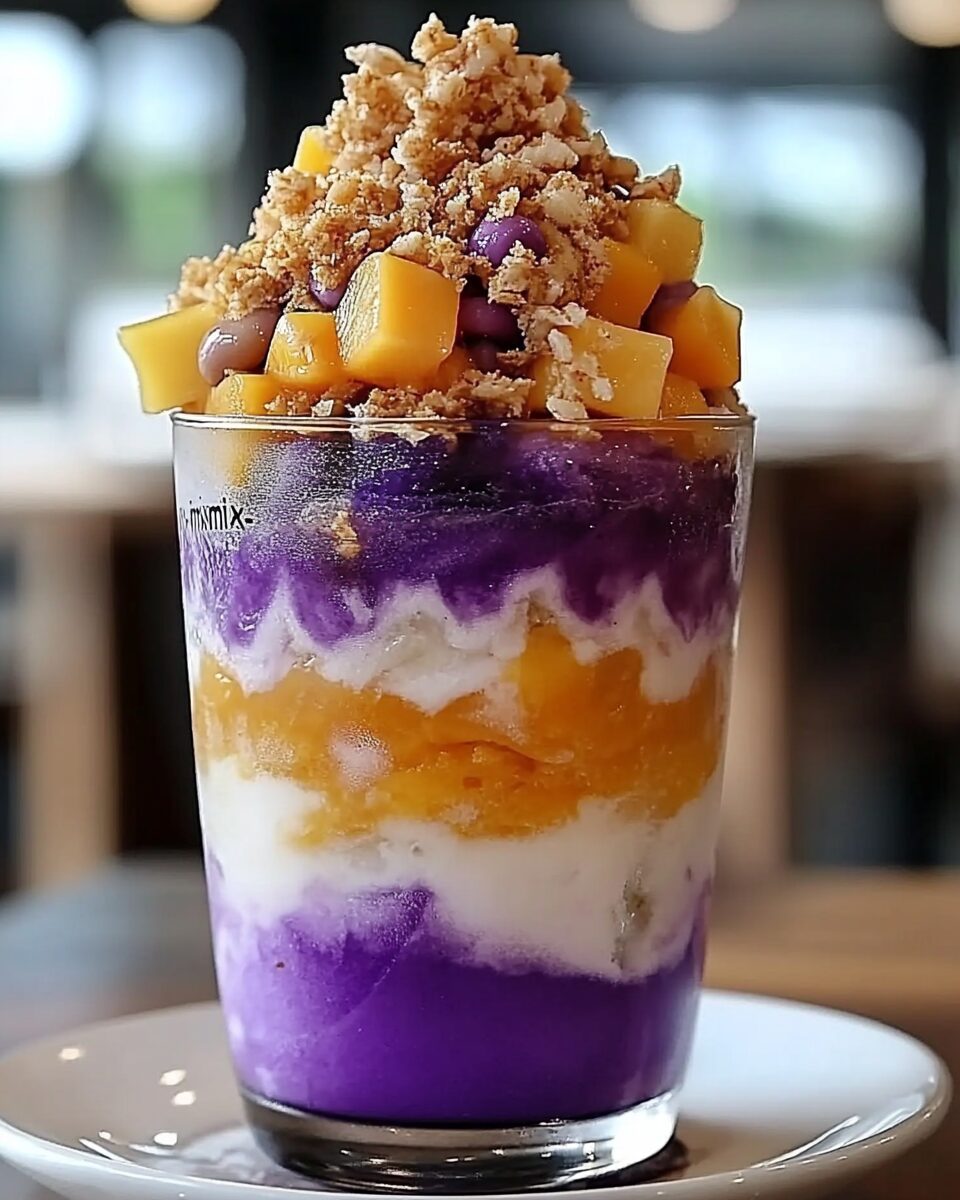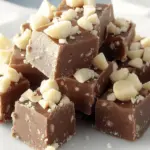Halo-halo, which means “mix-mix” in Filipino, is a beloved layered shaved ice dessert packed with tropical fruits, sweet beans, jellies, and topped with ube ice cream and leche flan. It’s the ultimate summer treat — refreshing, vibrant, and filled with textures and flavors that reflect the richness of Filipino culinary culture.
Full Recipe:
Ingredients (per 2 servings)
-
Base:
-
2 cups shaved or crushed ice
-
⅓ cup evaporated milk
-
-
Layer Fillings (adjust to taste):
-
¼ cup sweetened saba bananas or plantains
-
¼ cup sweetened jackfruit (langka)
-
¼ cup sweetened red mung beans
-
¼ cup sweetened garbanzo beans
-
¼ cup nata de coco or jelly cubes
-
¼ cup macapuno (coconut sport)
-
2 tbsp ube halaya (purple yam jam)
-
-
Toppings:
-
1 scoop ube ice cream
-
1 slice leche flan
-
Pinch of pinipig (toasted rice flakes) or crushed cornflakes
-
Directions
-
In a tall glass or bowl, layer each sweetened ingredient (fruits, beans, macapuno, nata de coco, etc.).
-
Add a generous layer of ube halaya on top.
-
Pack the glass with shaved or crushed ice until full.
-
Pour evaporated milk over the ice to soak through the layers.
-
Top with a scoop of ube ice cream and a slice of leche flan.
-
Sprinkle with pinipig or cornflakes for crunch.
-
Serve immediately with a long spoon — mix well before eating!
Nutrients (approx. per serving)
-
Calories: ~300–400 (varies by ingredients and quantities)
-
Fat: ~10g
-
Carbohydrates: ~50g
-
Sugar: High (mostly from sweetened fruits and condensed dairy)
-
Protein: ~4–6g
-
Fiber: ~2g
The Cultural Roots and Meaning of Halo-Halo
Halo-halo’s origin story is a reflection of the Philippines’ rich history of multicultural influences and local innovation. Thought to have been influenced by Japanese kakigori (shaved ice desserts with sweet toppings), the dessert evolved into a uniquely Filipino creation through the integration of native ingredients and flavors. Over time, it became a canvas of regional produce, street-side creativity, and communal enjoyment.
The name “halo-halo” itself is an instruction—it encourages diners to mix the layers together before eating. This blending of elements mirrors the diversity of Filipino culture, where native, Spanish, Chinese, and American influences mix in food, language, and daily life. With no strict rules about ingredients or proportions, every version of halo-halo is unique to the hands and tastes that prepare it, making it both a personal and cultural expression.
A Sensory Celebration in Every Spoonful
What makes halo-halo truly unforgettable is the variety of textures and flavors it delivers in each bite. From chewy nata de coco to soft macapuno strands, earthy mung beans to fruity jackfruit, and crunchy toppings like pinipig or cornflakes, the dessert is designed to be playful. It’s not just about flavor—it’s about contrast. Cold ice meets warm flavors. Creamy meets chewy. Sweet meets earthy. And bright colors swirl together into a pastel-hued whirlpool once stirred.
The ube halaya (purple yam jam) adds a rich, almost nutty base note with its natural sweetness and deep purple color. When paired with ube ice cream—arguably one of the dessert’s most visually striking components—it introduces a velvety, cool richness that ties the whole glass together. The leche flan, a custard made from egg yolks, milk, and sugar, adds a silky luxury to the experience. Its caramelized top and dense, creamy body contrast beautifully with the airy ice and soft fruit.
Then there’s the evaporated milk. Poured over the shaved ice, it soaks down through all the layers, softening beans and fruits and binding everything together with a milky sweetness that’s rich without being heavy. It’s this milk that gives halo-halo its signature creaminess, turning ice and fruit into a cohesive, chilled delight.
Customizable to Taste and Region
One of halo-halo’s greatest strengths is its adaptability. While some ingredients are traditional and widely used—like sweetened saba, macapuno, and ube—others vary depending on availability, preference, or regional variation. In some parts of the Philippines, versions might include cheese, tapioca pearls, gulaman (agar jelly), or even slices of fresh mango. Others may add crispy cereal or crushed peanuts as a topping for crunch.
This flexibility makes halo-halo a dessert of infinite variation. Whether made from scratch at home, purchased from a local street vendor, or ordered at a modern dessert café, it reflects local tastes and personal flair. It’s an open invitation to play with texture and color while still honoring tradition.
Even the milk base can vary. Some recipes use evaporated milk, others incorporate condensed milk or coconut milk for extra sweetness or a dairy-free option. Plant-based versions using almond or oat milk and dairy-free ice cream are also increasingly popular.
Perfect for Sharing or Savoring Solo
Halo-halo is meant to be savored slowly, with a long spoon and a wide-mouthed glass or bowl that allows you to dig down and mix thoroughly. This makes it a social dessert—something to be enjoyed with friends or family, passed around the table, or shared over conversations and laughter. It’s often served at Filipino gatherings and parties as a crowd-pleaser that cools and delights at the same time.
It’s also perfectly enjoyable solo, especially on a hot afternoon when you need a refreshing pick-me-up. As a cold dessert, it’s incredibly effective at beating the tropical heat, but its complexity also gives it staying power—it’s not just a quick bite, but an experience to linger over.
A Celebration of Filipino Ingredients
Halo-halo is more than just a dessert—it’s an edible showcase of the Philippines’ culinary and agricultural richness. It uses native ingredients like saba bananas, macapuno (a rare coconut variety with soft, jelly-like flesh), and ube, which have long been staples of Filipino cuisine. The beans and jellies add heartiness, making halo-halo one of the few desserts that can also feel satisfyingly filling.
For many Filipinos, halo-halo is tied to memories of childhood, vacations in the province, or summers spent cooling down in backyard kitchens and seaside stalls. It’s a nostalgic dish, rich with personal and collective meaning, often remembered not just for its taste, but for the moments surrounding it.
Nutritional Considerations
While halo-halo is a treat, it’s worth noting that its ingredients—though sweet—offer a variety of nutrients. Sweetened beans and fruits provide fiber and protein, while ube adds antioxidants and vitamins. However, it’s also high in sugar, particularly from the condensed milk, sweetened fruits, and ice cream, so moderation is key.
A typical serving falls in the range of 300 to 400 calories, depending on portion size and exact ingredients. For a lighter version, you can use reduced-sugar beans, skip the flan, or use low-fat milk alternatives while still retaining much of the flavor and enjoyment.
Conclusion
Halo-halo is more than just a dessert—it’s a celebration of flavor, culture, and joyful abundance. Layered with sweetened fruits, native treats, creamy ube and leche flan, and topped with cooling shaved ice and milk, it delivers a unique experience in every spoonful. It’s playful, colorful, and deeply satisfying—a perfect representation of the warmth and hospitality found in Filipino food culture.
Whether you’re trying it for the first time or revisiting a childhood favorite, halo-halo invites you to slow down, stir things up, and savor a delicious mix of textures, temperatures, and traditions. It’s summer in a glass, a cultural icon, and a reminder that sometimes the most beautiful things come from simply mixing everything together.






